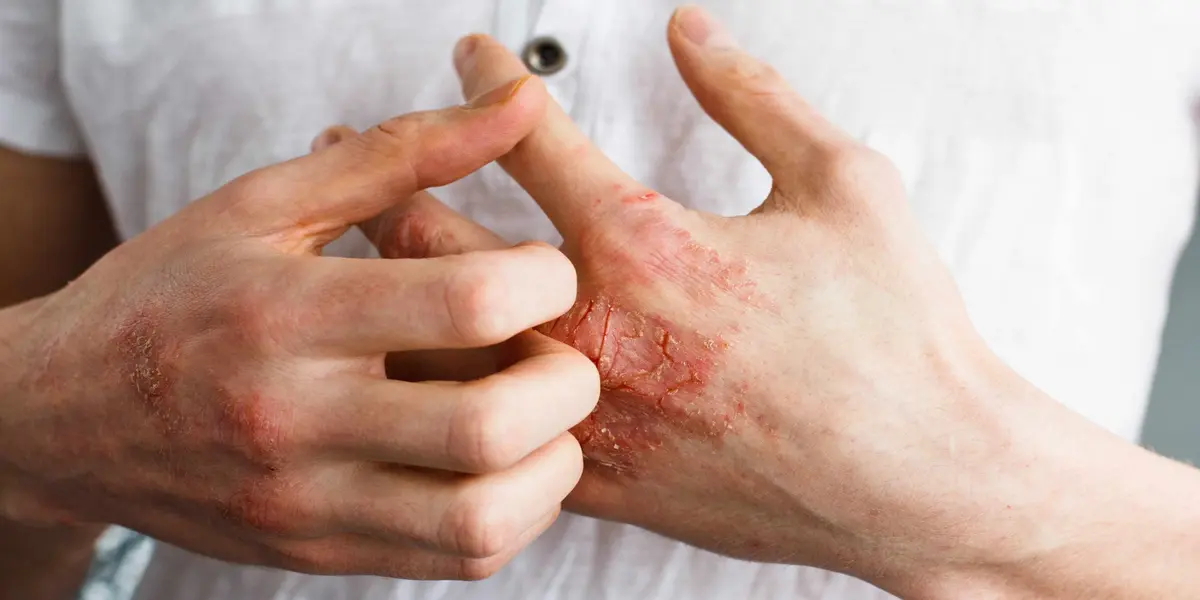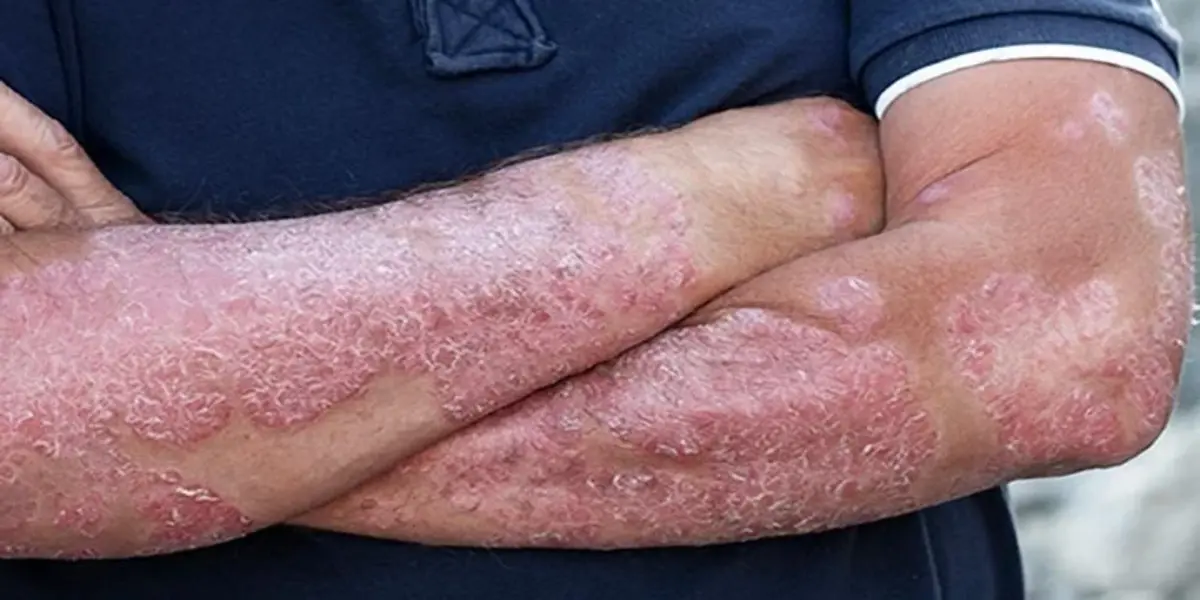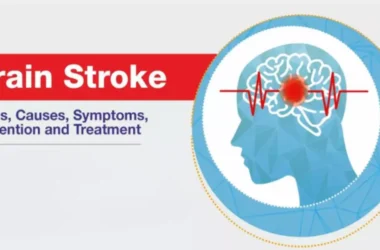Skin disorders encompass a broad range of conditions that can affect your skin in various ways. They can be temporary or permanent and may be painless or painful.
Some have situational causes, while others may be genetic. Skin conditions can affect any part of the body and are influenced by environmental factors, genetic predisposition, and health conditions.
Identifying Different Types of Skin Disorders
There are numerous types of skin disorders, each with unique symptoms and treatment options. Here’s a closer look at some of the most prevalent skin conditions.
1. Acne

What it is: Acne is perhaps the most well-known skin disorder, characterized by pimples, blackheads, and whiteheads. It primarily affects people during puberty but can continue into adulthood.
Treatment
Over-the-Counter (OTC) Treatments
Many acne treatments are available without a prescription. These include creams, gels, and lotions that contain active ingredients like benzoyl peroxide, salicylic acid, and alpha-hydroxy acids. These substances help reduce oil production, speed up skin cell turnover, and fight bacterial infection, thereby reducing inflammation.
Prescription Medications
For moderate to severe acne, a dermatologist may prescribe stronger medications. These can include topical retinoids, topical antibiotics, or oral medications like antibiotics or isotretinoin (Accutane). Oral contraceptives are sometimes recommended for women experiencing acne due to hormonal fluctuations.
Medical Procedures
In cases of severe acne, medical procedures might be necessary. Options include:
- Chemical peels: These can help by peeling away the top layer of skin, which opens pores and removes dead skin cells.
- Light therapy: Reducing bacteria and decreasing oil production on the skin can be achieved with various forms of light and laser therapy.
- Extraction of blackheads and whiteheads: Dermatologists use special tools to safely remove clogged pores that don’t respond to topical treatments.
Prevention of Acne
Preventing acne involves maintaining a routine that supports skin health and avoids common triggers:
Proper Skincare
- Cleansing: Wash your face twice daily with a mild cleanser to remove excess oil and dirt.
- Exfoliating: Use a gentle exfoliant to help clear pores of dead skin cells, but avoid over-exfoliating as it can irritate the skin and exacerbate acne.
- Moisturizing: Even oily skin needs moisture. Use an oil-free, non-comedogenic moisturizer to keep skin hydrated without clogging pores.
Lifestyle Adjustments
- Diet: While no definitive link between diet and acne has been proven, some people find that certain foods (like those high in sugar and dairy products) can trigger flare-ups. Keeping a food diary may help identify potential triggers.
- Stress Management: Stress can increase the production of hormones that worsen acne. Techniques such as yoga, meditation, and regular exercise can help manage stress levels.
- Sleep: Adequate sleep is crucial for overall skin health. Aim for 7-9 hours per night to allow the skin to repair and regenerate.
Avoid Common Triggers
- Makeup and Skin Products: Choose products labeled as “non-comedogenic” which are less likely to clog pores.
- Hair Care Products: Be mindful of oils and ingredients in hair care products that might contribute to facial breakouts, especially around the forehead.
- Touching Your Face: Avoid touching your face throughout the day to prevent the spread of bacteria and irritation to your skin.
Regular Medical Check-ups
Consult with a dermatologist for personalized advice and to ensure that your acne treatment regimen remains effective. Regular check-ups allow for adjustments based on changes in your skin condition or side effects.
2. Eczema

What it is: Eczema, or atopic dermatitis, causes the skin to become red, itchy, and inflamed. It’s common in children but can occur at any age.
Treatment and Prevention
Understanding Eczema Triggers
The first step in managing eczema is identifying and avoiding triggers that can cause flare-ups. Common triggers include:
- Irritants: Such as soaps, detergents, shampoos, and disinfectants that can cause skin irritation when in contact.
- Allergens: Pollen, dust mites, pet dander, and molds can trigger eczema.
- Foods: Dairy, nuts, soy, and gluten might exacerbate symptoms in some people.
- Environmental Factors: Extreme temperatures and humidity can prompt eczema symptoms.
- Stress: Emotional stress does not cause eczema but can worsen the symptoms.
Daily Skin Care Routine
Maintaining an eczema-friendly skincare routine can significantly reduce dryness and irritation. Key components include:
- Gentle Cleansing: Use a mild, fragrance-free cleanser and avoid scrubbing the affected areas.
- Moisturizing: Apply a rich moisturizer immediately after bathing to lock in moisture. Creams and ointments are usually more effective than lotions for eczema.
- Lukewarm Baths: Opt for short, lukewarm baths or showers to prevent skin from drying out.
Medications and Topical Treatments
Several medications can help manage eczema symptoms:
- Topical Corticosteroids: Creams and ointments that reduce inflammation and relieve itching.
- Calcineurin Inhibitors: Prescribed for treating inflammation and halting flare-ups.
- PDE4 Inhibitors: A newer class of topical medication that helps control inflammation.
- Biologics: Advanced medication used for severe eczema, targeting overactive parts of the immune system.
Lifestyle Modifications
Lifestyle changes can also play a significant role in managing eczema:
- Dietary Adjustments: Some individuals find relief by altering their diet. Keeping a food diary can help identify potential food triggers.
- Fabric Choices: Wear soft, breathable clothing and avoid rough, scratchy fibers like wool.
- Stress Management: Techniques such as yoga, meditation, or therapy can reduce stress-related flare-ups.
Advanced Therapies
When conventional treatments are not effective, doctors might recommend advanced therapies:
- Phototherapy: Exposure to ultraviolet light under medical supervision can reduce symptoms of severe eczema.
- Immunosuppressants: For severe cases, medications that suppress the immune system might be necessary.
Regular Follow-up
Regular visits to a dermatologist are crucial for effectively managing eczema. These appointments can help fine-tune treatments based on the individual’s current skin condition and response to previous therapies.
3. Psoriasis

What it is: Psoriasis is a chronic condition that leads to the overproduction of skin cells, causing thick, scaly patches that are often itchy or painful.
Effective Treatments for Psoriasis
1. Topical Treatments
Topical treatments are medications applied directly to the skin and are usually the first line of defense in managing mild to moderate psoriasis. These include:
- Corticosteroids: These are the most common treatments for psoriasis. They reduce inflammation and relieve itching.
- Vitamin D analogues: These compounds help slow down skin cell growth.
- Anthralin: This helps to normalize DNA activity in skin cells and remove scales, making the skin smoother.
- Topical retinoids: These are vitamin A derivatives that may decrease inflammation.
- Calcineurin inhibitors: Typically used for reducing inflammation and plaque buildup.
2. Light Therapy
Light therapy involves exposing the skin to ultraviolet light on a regular basis and under medical supervision. Treatments can include:
- Sunlight: Regular short exposures to small amounts of natural sunlight may improve psoriasis.
- UVB Phototherapy: Controlled doses of UVB light from an artificial light source may improve mild to moderate psoriasis.
- Psoralen plus ultraviolet A (PUVA): This treatment involves taking a light-sensitizing medication (psoralen) before exposure to UVA light.
3. Systemic Treatments
For more severe cases, doctors might prescribe oral or injected medications that treat the whole body. These include:
- Methotrexate: A chemotherapy agent that can control psoriasis by slowing skin cell growth.
- Cyclosporine: Suppresses the immune system to slow down the rapid turnover of skin cells.
- Biologics: Targeted drugs that affect parts of the immune system that play a role in causing psoriasis.
4. Alternative Therapies
Some people find relief using alternative therapies such as:
- Aloe Vera: Applying aloe extract cream may reduce redness and scaling associated with psoriasis.
- Fish Oil: Oral fish oil therapy used in conjunction with ultraviolet B therapy may reduce psoriasis symptoms.
- Oregon Grape: Topical application of Oregon grape may reduce inflammation and ease psoriasis symptoms.
Prevention Strategies for Psoriasis
While psoriasis outbreaks can be unpredictable, certain strategies can help manage and possibly prevent flare-ups:
- Moisturizing: Keeping skin moist is important to prevent dryness and reduce irritation.
- Diet and Lifestyle: Healthy eating, including plenty of fruits and vegetables, and maintaining a balanced diet can support overall health and potentially ease psoriasis symptoms.
- Stress Management: Since stress can trigger psoriasis flare-ups, finding effective ways to relax and manage stress can be beneficial.
- Avoiding Triggers: Common triggers include smoking, heavy alcohol consumption, and withdrawal from systemic steroids. Identifying personal triggers and avoiding them can help manage symptoms.
4. Rosacea

What it is: Rosacea is a chronic skin condition that causes facial redness and sometimes small, red, pus-filled bumps. It typically begins after 30 and affects more women than men.
Treatment and Prevention
Medical Treatments
- Topical Medications: Doctors often prescribe topical treatments to reduce inflammation and redness. These can include metronidazole, azelaic acid, and ivermectin. Applying these creams or gels as directed can control the symptoms effectively.
- Oral Medications: In more severe cases, oral antibiotics like doxycycline or minocycline may be recommended. For cases where rosacea causes thickening of the skin, isotretinoin, a powerful oral medication, may be used, albeit under strict medical supervision due to its potential side effects.
- Laser and Light Therapy: Treatments such as laser therapy can help reduce the visibility of blood vessels (telangiectasia) and remove any excessive redness. These procedures should be conducted by qualified professionals and may require multiple sessions.
Lifestyle Adjustments
- Identify and Avoid Triggers: Many individuals with rosacea notice that certain lifestyle and environmental factors trigger their symptoms. Common triggers include hot foods, spicy foods, alcohol, extreme temperatures, sunlight, stress, and certain skincare products. Keeping a symptom diary can help identify personal triggers.
- Skin Care: Using gentle skincare products is crucial. Non-abrasive cleansers, moisturizers free of alcohol, and sunscreens designed for sensitive skin can help manage rosacea. Avoid rubbing or scrubbing your face, as this can irritate your skin further.
- Dietary Considerations: Although dietary impacts vary, some people find that avoiding hot and spicy foods, caffeine, and alcoholic beverages can help control flare-ups.
- Stress Management: Since stress can exacerbate rosacea, incorporating stress-reduction techniques such as yoga, meditation, or regular exercise into your routine might reduce the frequency and severity of flare-ups.
Preventive Measures
Preventing rosacea involves a combination of avoiding known triggers and proactive skincare. Regular visits to a dermatologist, staying informed about the condition, and adhering to a tailored treatment plan are all integral parts of managing rosacea effectively.
Also Read: Navigating Psoriatic Arthritis: Insights and Innovations in Managing Skin and Joint Health
Additionally, protecting your face from sun exposure by wearing broad-spectrum sunscreen with an SPF of 30 or higher and using hats and umbrellas can significantly help in reducing flare-ups.
When to See a Doctor
If you suspect you have rosacea, or if your symptoms worsen or do not respond to initial treatments, consulting a dermatologist is essential.
Early and accurate diagnosis, coupled with professional guidance on treatment options, provides the best chance for managing this condition and maintaining a healthy, confident outlook.
5. Vitiligo

What it is: Vitiligo involves the loss of skin color in blotches. The extent and rate of color loss are unpredictable.
Treatment Options for Vitiligo
1. Topical Treatments
Topical corticosteroids are often the first line of treatment for vitiligo. These can be effective in restoring pigment, especially in the early stages of the disease.
Another topical option is calcineurin inhibitors, such as tacrolimus or pimecrolimus, which are used particularly for vitiligo on the face and neck due to a lower risk of skin thinning.
2. Phototherapy
Phototherapy involves the use of ultraviolet light to stimulate melanocytes in the skin. Narrowband UVB therapy is currently the most common phototherapy option for vitiligo.
It requires consistent sessions over a period of months and is most effective when combined with other treatments.
3. Laser Treatment
Excimer lasers can also be used to treat vitiligo. This method uses a focused beam of UVB light and is particularly effective for small areas of depigmentation.
The treatment is usually done twice a week and may take several months to see significant improvements.
4. Skin Grafting
In more severe cases, skin grafting might be an option. This procedure involves transferring pigmented skin from one area of the body to another.
It’s more invasive and generally reserved for patients who do not respond to other treatments.
5. Depigmentation
In cases where vitiligo covers a large area of the body, depigmentation of the remaining pigmented skin might be considered to even out the skin tone.
This is typically achieved through the topical application of drugs like monobenzone.
6. Cosmetic Options
Cosmetic options such as makeup or self-tanners can also be used to cover up depigmented patches. Additionally, tattooing, although less commonly recommended due to risks of further skin damage, is another option for stable vitiligo.
Prevention Strategies
Since the exact cause of vitiligo is still not fully understood, specific prevention strategies are limited.
However, managing overall skin health can potentially help in reducing the risk or slowing the progression of the disease:
1. Protect Against Skin Damage
Skin trauma can sometimes trigger vitiligo or exacerbate it. Protecting your skin by using sunscreen and avoiding unnecessary skin irritations is advisable.
2. Manage Stress
As with many autoimmune conditions, stress can exacerbate vitiligo. Stress management techniques such as yoga, meditation, and regular exercise can be beneficial.
3. Diet and Supplements
While no specific diet can prevent vitiligo, maintaining a balanced diet rich in vitamins and minerals can support overall skin health.
Some people believe that certain vitamins and minerals like vitamin B12, folic acid, and vitamin D might help prevent its progression, though more research is needed in this area.
4. Regular Check-ups
Regular visits to a dermatologist can help catch any changes in skin condition early, potentially allowing for earlier intervention and better management of the condition.
6. Hives

What it is: Hives are red, itchy welts that can occur as a result of an allergic reaction or other causes.
Treatment Options for Hives
- Antihistamines: These are the first line of treatment for hives. Over-the-counter (OTC) antihistamines like cetirizine, fexofenadine, or diphenhydramine can help relieve itching and reduce the appearance of the welts. For chronic hives, a doctor may prescribe stronger antihistamines.
- Corticosteroids: For severe outbreaks, corticosteroids such as prednisone can be prescribed to reduce swelling, redness, and itching. However, these are generally used only for short-term treatment due to potential side effects with long-term use.
- Epinephrine: In cases where hives are accompanied by severe allergic reactions or angioedema (swelling deep under the skin), an epinephrine injection may be necessary. This is a medical emergency treatment.
- Other Medications: For chronic hives, other medications like leukotriene receptor antagonists (e.g., montelukast) and immunosuppressants (e.g., cyclosporine) may be used under careful medical supervision.
Prevention Strategies for Hives
- Identify and Avoid Triggers: One of the most effective ways to prevent hives is to identify and avoid known triggers. Common triggers include certain foods (like nuts, shellfish), medications (like NSAIDs, antibiotics), environmental factors (like pollen, pet dander), and physical stimuli (like pressure, temperature changes).
- Manage Stress: Stress is a known trigger for hives. Techniques such as mindfulness, yoga, and regular exercise can help manage stress levels, potentially reducing the frequency and severity of hives outbreaks.
- Maintain a Diary: Keeping a diary of your hives outbreaks along with details on what you ate, activities, and stress levels can help identify potential triggers and patterns. This information can be invaluable for managing the condition effectively.
- Diet and Supplements: Although more research is needed, some people find that a diet high in anti-inflammatory foods (like omega-3 fatty acids, leafy greens, and berries) and supplements such as vitamin D or probiotics can help manage their symptoms.
When to See a Doctor
It’s important to consult a healthcare professional if:
- The hives persist for more than a few days or recur frequently.
- You experience other symptoms, such as difficulty breathing, swelling around the lips or eyes, or dizziness.
- OTC treatments are not effective.
A dermatologist or allergist can provide more specialized care and potentially recommend allergy testing or other diagnostic procedures to better understand and manage the condition.
How Skin Disorders Impact Emotional Well-being
Skin disorders are not just a physical concern but also affect emotional health. Conditions like psoriasis and eczema can lead to decreased self-esteem, social anxiety, and depression due to their visible symptoms.
Managing Emotional Effects
Support from family, friends, and support groups can help individuals cope with the emotional challenges posed by skin disorders. Professional counseling may also be beneficial.
The Importance of Professional Diagnosis
While recognizing symptoms is crucial, a professional diagnosis is essential to manage any skin condition effectively.
Dermatologists can offer guidance based on an individual’s specific symptoms and medical history.
When to See a Dermatologist
If skin problems persist or cause significant discomfort, it is advisable to visit a dermatologist. Early diagnosis and treatment often lead to better outcomes.
Conclusion
Skin disorders vary widely in symptoms and severity and managing them effectively requires a comprehensive approach that includes proper diagnosis, treatment, and emotional support.
By understanding the common types of skin disorders and their treatments, individuals can take proactive steps towards managing their condition and improving their quality of life.
Remember, maintaining skin health is not only about managing disorders but also about adopting a lifestyle that supports overall skin health.
Regular skincare, a balanced diet, and adequate hydration are fundamental to keeping skin healthy and resilient against disorders.




